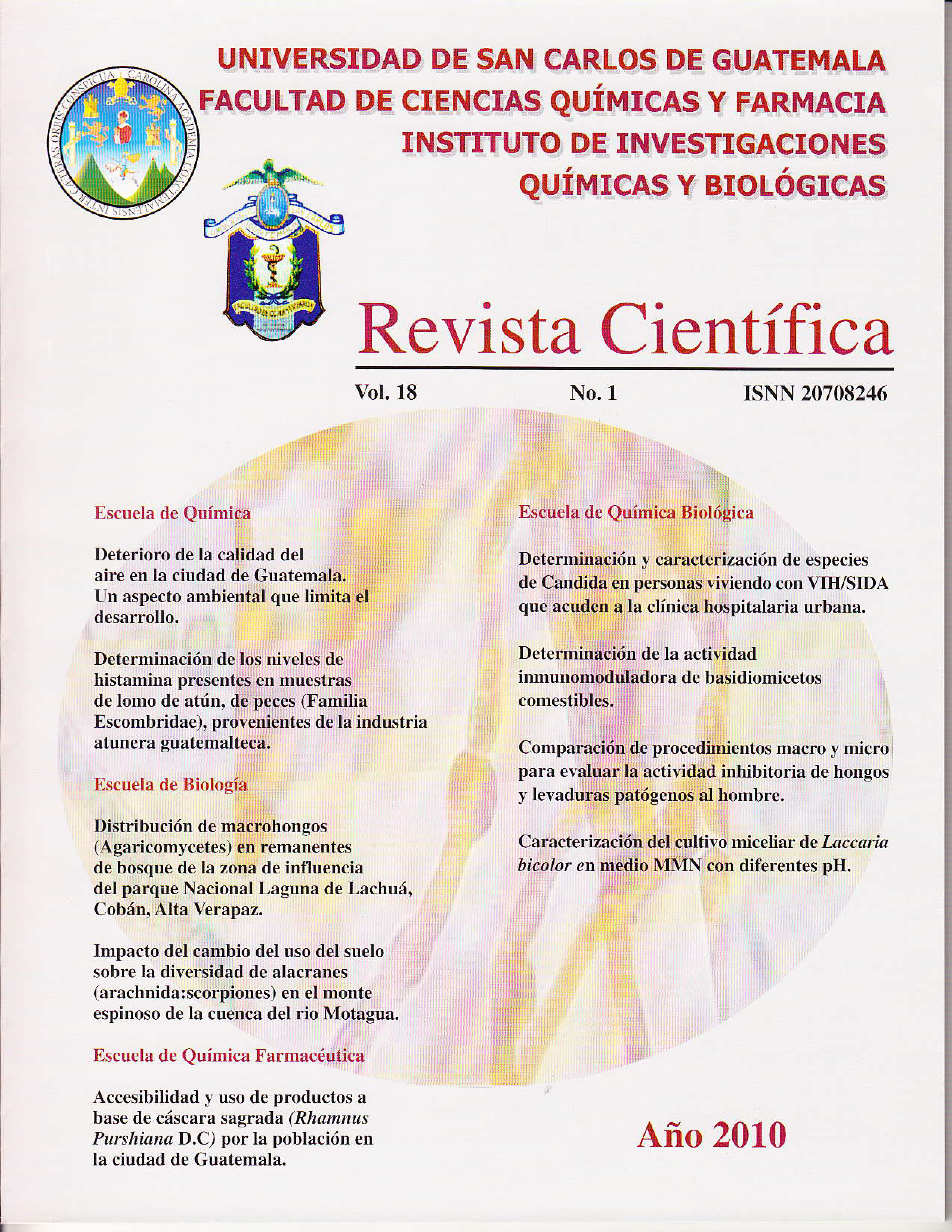Distribution of Macrofungi (Agaricomycetes) in remnants of forest in the area of influence of Laguna Lachuá National Park, Cobán, Alta Verapaz
DOI:
https://doi.org/10.54495/Rev.Cientifica.v18i1.165Keywords:
Lachuá Lagoon National Park, macrofungiAbstract
To understand how the geometry and size of the forest remnants affect the distribution of macrofungi, eight remnants from the zone of influence -ZI- of the Laguna Lachuá National Park -PNLL- were taken as a sample; four with rectangular geometry and four with square geometry. In addition to geometry, two remnant sizes were determined in the total sample, four large and four small. In each of them, two perpendicular transects were established that crossed the length and width of the remnant, on the transect, circular plots of 5m2 were established every 5 meters. collecting the total number of macrofungi found. Physicochemical factors were measured that could be conditioned by the size and shape of the forest remnant and therefore influence the distribution of fungi; among them: light density in the canopy, physicochemical composition of the soil and organic matter, and presence of trees with a diameter at breast height - DBH - greater than 10. 170 morphospecies of macrofungi of the Agaricomycetes class were collected in the eight forest remnants of Zl. the most abundant families were Tricholomataceae and Polyporaceae. The response of macrofungi to gradients within remnants responds to size, since large remnants have a greater number of specimens. The edge effect is perceived in remnants with rectangular geometry regardless of size. No plant-fungus specificity was found that affected its distribution within the remnants. The physicochemical factor that determines the distribution of macrofungi is organic matter, since it responds to! edge effect on remnants with rectangular geometry.
Downloads
References
Bennet A. 1999. Enlazando el Paisaje: El papel de los corredores y la conectividad en la conservación de la vida Silvestre. Blanch (Trad). Reino Unido: UTCN. Gland Suiza y Cambridge. 27 6p.
Bustamante R. y A, A. Grez, 1995. Consecuencias ecológicas de la fragmentación de los bosques nativos. Ambiente y Desarrollo 11(2): 58-63.
Forman R. y Godron M. 1 986. Landscape Ecology. United States: John Wiley & sons, Inc. 619 pp.
Guzmán G. 2003. Hongos del El Edén Quintana Roo: Introducción a la micobiota tropical de México. Xapala, México: Instituto Nacional de Ecología. 316p, https://doi.org/10.1590/S0036-46652004000500017 DOI: https://doi.org/10.1590/S0036-46652004000500017
Halffter G. 1 998. Una estrategia para medir la Biodiversidad a Nivel de Paisaje. Halffter (comp.) La Diversidad Biológica de Iberoamérica IT, Vol. Especial, Acta Zoológica Mexicana, Nueva Serie. 377pp.
Imagen Landsat 7 (17-2049) 30 de Marzo 2001
INAB 2003. PLAN MAESTRO Parque Nacional Laguna Lachuá Cobán, Alta Verapaz 119p.
Jongman R, Ter Braak & O. Van Tongeren. 1995. Data Analysis in Community and Landscape Ecology. New York: Cambridge University Press. XXI+299 p, https://doi.org/10.1017/CBO9780511525575 DOI: https://doi.org/10.1017/CBO9780511525575
Mueller G., Bills G. y Foster M. 2004. Biodiversity of Fungi: Inventory and Monitoring Methods. USA: Elsevier. 777pp.
Quezada M. 2005 Análisis de la distribución y riqueza del Orden Agaricalcs (Macrohongos) en relación con los paisajes antropogénicos en la zona de influencia del Parque Nacional Laguna Lachuá, Cobán. Alta Verapaz. Guatemala: Universidad de San Carlos (Tesis Licenciatura, Facultad de Ciencias Químicas y Farmacia) 68p.
Downloads
Published
How to Cite
Issue
Section
License
Copyright (c) 2010 R. López, M. Quezada

This work is licensed under a Creative Commons Attribution 4.0 International License.
Authors who publish with this journal agree to the following terms:
- Authors retain copyright and grant the journal right of first publication with the work simultaneously licensed under a Creative Commons Attribution License 4.0 that allows others to share the work with an acknowledgement of the work's authorship and initial publication in this journal.
- Authors are able to enter into separate, additional contractual arrangements for the non-exclusive distribution of the journal's published version of the work (e.g., post it to an institutional repository or publish it in a book), with an acknowledgement of its initial publication in this journal.
- Authors are permitted and encouraged to post their work online (e.g., in institutional repositories or on their website) prior to and during the submission process, as it can lead to productive exchanges, as well as earlier and greater citation of published work.









